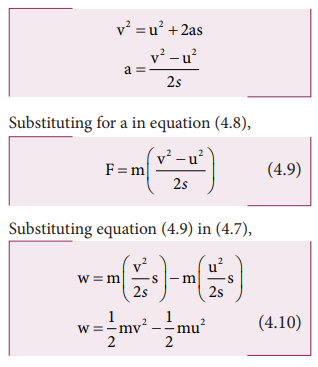Chapter: 11th Physics : UNIT 4 : Work, Energy and Power
Work-Kinetic Energy Theorem
Work-Kinetic Energy Theorem
Work and energy are equivalents. This is true in the case of kinetic energy also. To prove this, let us consider a body of mass m at rest on a frictionless horizontal surface.
The work (W) done by the constant force (F) for a displacement (s) in the same direction is,

The constant force is given by the equation,

The third equation of motion (refer section 2.10.3) can be written as,

The expression for kinetic energy:
The term ½ mv2 in the above equation is the kinetic energy of the body of mass (m) moving with velocity (v).

Kinetic energy of the body is always positive. From equations (4.10) and (4.11)

The expression on the right hand side (RHS) of equation (4.12) is the change in kinetic energy (∆KE) of the body.

This implies that the work done by the force on the body changes the kinetic energy of the body. This is called work-kinetic energy theorem.
The work-kinetic energy theorem implies the following.
i. If the work done by the force on the body is positive then its kinetic energy increases.
ii. If the work done by the force on the body is negative then its kinetic energy decreases.
iii. If there is no work done by the force on the body then there is no change in its kinetic energy, which means that the body has moved at constant speed provided its mass remains constant.
Related Topics